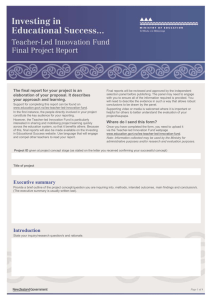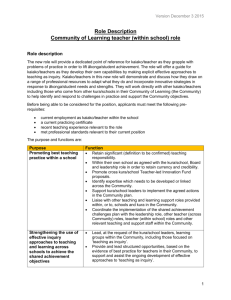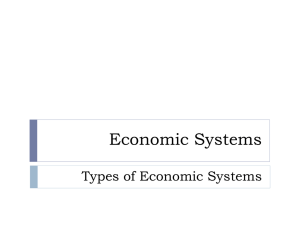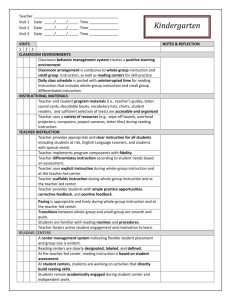IES Teacher-Led Innovation Fund Concept Form - M*ori
advertisement
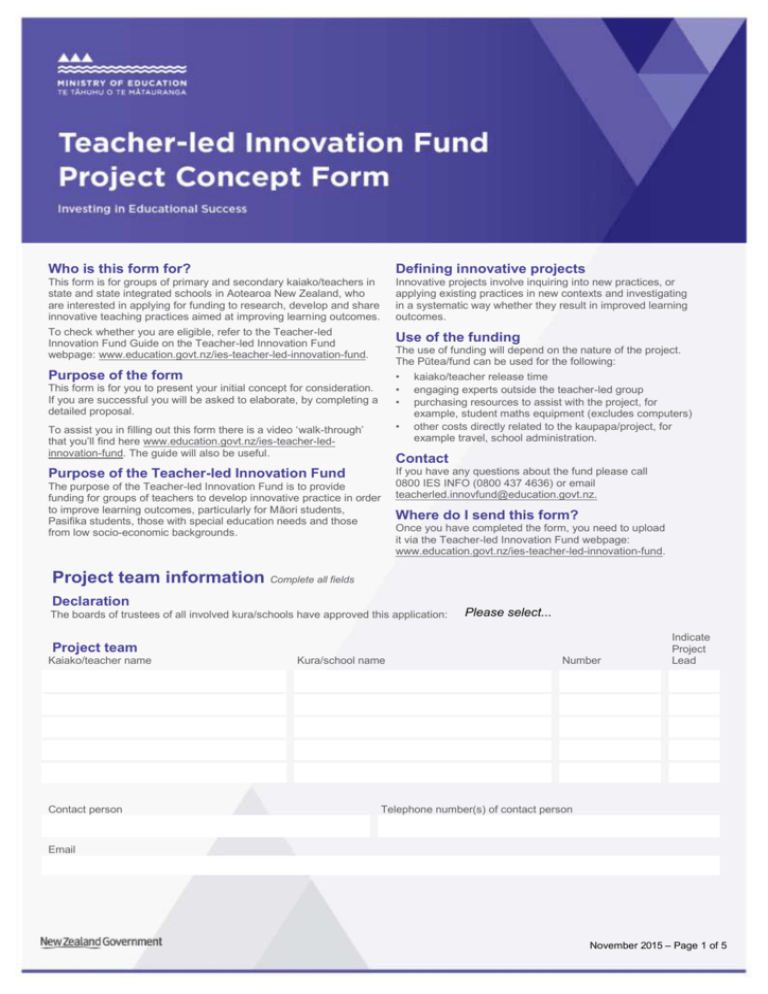
Who is this form for? Defining innovative projects This form is for groups of primary and secondary kaiako/teachers in state and state integrated schools in Aotearoa New Zealand, who are interested in applying for funding to research, develop and share innovative teaching practices aimed at improving learning outcomes. Innovative projects involve inquiring into new practices, or applying existing practices in new contexts and investigating in a systematic way whether they result in improved learning outcomes. To check whether you are eligible, refer to the Teacher-led Innovation Fund Guide on the Teacher-led Innovation Fund webpage: www.education.govt.nz/ies-teacher-led-innovation-fund. Use of the funding Purpose of the form • • • The use of funding will depend on the nature of the project. The Pūtea/fund can be used for the following: This form is for you to present your initial concept for consideration. If you are successful you will be asked to elaborate, by completing a detailed proposal. kaiako/teacher release time engaging experts outside the teacher-led group purchasing resources to assist with the project, for example, student maths equipment (excludes computers) other costs directly related to the kaupapa/project, for example travel, school administration. To assist you in filling out this form there is a video ‘walk-through’ that you’ll find here www.education.govt.nz/ies-teacher-ledinnovation-fund. The guide will also be useful. • Purpose of the Teacher-led Innovation Fund If you have any questions about the fund please call 0800 IES INFO (0800 437 4636) or email teacherled.innovfund@education.govt.nz. Contact The purpose of the Teacher-led Innovation Fund is to provide funding for groups of teachers to develop innovative practice in order to improve learning outcomes, particularly for Māori students, Pasifika students, those with special education needs and those from low socio-economic backgrounds. Where do I send this form? Once you have completed the form, you need to upload it via the Teacher-led Innovation Fund webpage: www.education.govt.nz/ies-teacher-led-innovation-fund. Project team information Complete all fields Declaration The boards of trustees of all involved kura/schools have approved this application: Please select... Project team Kaiako/teacher name Contact person Kura/school name Number Indicate Project Lead Telephone number(s) of contact person Email November 2015 – Page 1 of 5 Part A: Project Concept Introduction The project concept has four parts, with several questions within each part. The sections are: a. b. c. d. Concept overview Collaborative inquiry and practice Impact of your project Estimated funding and timeframe State the title of your concept (in ten words or less). Who is this project for and what is the benefit they will receive? (100 words or less) Concept overview This section allows you to present an initial concept for consideration. The concept is the idea you wish to investigate. (Please respond to each question in Part A with 250 words or less) Describe your concept, and how it is innovative. Refer to the definition of ‘innovative projects’ on Page 1 of this form. Identify your puzzle of practice, what you want to investigate and your inquiry question/s. November 2015 – Page 2 of 5 Describe the educational need to be addressed, and how the purpose of your kaupapa/project links to the purpose of the fund (as stated on Page 1 of this form). Using evidence, describe why you have chosen this puzzle of practice, and why it is likely to be effective or worth pursuing. Part B: Collaborative inquiry and practice This section focuses on collaborative ways of working, and how your project team will work together. (Please respond to each question in Part B with 50 words or less) Describe the teachers involved in the project team, the particular expertise they will bring to the project and the way the team will work together. Describe any communities you will engage with and how you will engage relevant to your proposed project. November 2015 – Page 3 of 5 Describe any technical (or other kinds of) experts you will use, and how they will contribute to the collaborative inquiry and rigour of the proposed project. Describe any others with whom you plan to collaborate. Part C: Methodology and design Complete the following table: Inquiry Intended outcome/s Question/s What the team anticipates the results of the projects will be What data will be collected Possible sources of data Part D: Impact of project This section looks at expected outcomes and benefits. It is not expected that, at concept stage, you will have measurable success criteria. (Please respond to each question in Part D with 50 words or less) Monitoring and evaluation Describe how you will know if your project/kaupapa has been a success/met your intended outcome Refer to the Basket of Evidence in Investing in Educational Success Working Group Report Basket of evidence – Ministry of Education (Page 115 in hard copy). Describe how your inquiry idea has the potential to be used in other educational settings. What sector(s) would the project involve? (Tick all that apply) Early Childhood Education/schools Schools Schools/tertiary November 2015 – Page 4 of 5 Part E: Estimated funding and timeframe This section asks you to make estimations of costings, timeframe and numbers of teacher participants. The timeframe and costs need to reflect the scope and scale of your project. Make some estimations around funding, time frame and teachers involved.1 Note: The Teacher-led Innovation Fund Guide explains the funding details (www.education.govt.nz/ies-teacher-led-innovation-fund). Estimated funding $0.00 Estimated timeframe in school terms Estimated number of teachers Funding Category A/B/C (Refer Guide) Select... 1 We understand that some things may change between project concept and project proposal, particularly the funding and time frame estimates. These are initial figures only, to start planning. More detailed information will be expected in the subsequent project proposal. Note: Information collected may be used by the Ministry for administrative purposes and/or research and evaluation purposes. November 2015 – Page 5 of 5
